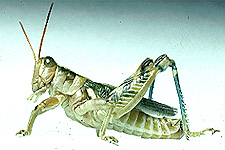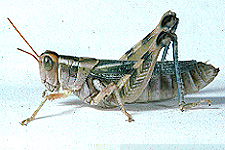Grasshoppers of Wyoming and the West
Entomology
Aeoloplides turnbulli (Caudell)
 |
 |
| Adult male | Adult female |
Common name - Thistle grasshopper (Coppock, 1962).
Recent synonymy - Aeoloplus turnbulli (Caudell).
Geographic distribution - North Dakota, South Dakota, Wyoming, Kansas, Nebraska, Colorado, New Mexico and Texas (Brooks, 1958). The subspecies A. turnbulli bruneri is common on the plains of eastern Colorado. A. turnbulli turnbulli is found in the mountains of the Colorado Front Range. A. turnbulli also is found in the northwest corner of the state (Alexander, 1941).
Habitat - dry alkaline areas in eroded, mixed prairie; often found on such dry herbage as the plants of the goosefoot family (Brooks, 1958; Hebard, 1928).
Food habits - a forb feeder that eats mainly Russian thistle, belvedere summercypress, white sage, saltbush, black greasewood and other plants of the goosefoot family (Anderson and Wright, 1952; Gillette, 1904; Rottman, 1980). Occasionally it may feed on sugarbeet (Smith, 1954).
Eggs - females lay about 18 tan eggs per pod. Eggs are arranged in two columns with froth between the eggs. Average egg length, 4.2 mm; average diameter, 1.2 mm (Onsager and Mulkern, 1963).
Adult - medium size. General color is grey-green. Face is slightly slanted back. Vertex is rounded. Antennae are slender and red. Head is yellowish with a green stripe on top, which continues along the top of the pronotum but is wider and yellow in the middle. Lateral lobes of pronotum also have broad green stripes. Dorsal posterior margin of pronotum is at an obtuse angle. Spine between front legs is more slender and sharply conical than in Melanoplus. Tegmina are pale green. Wings are clear. Hind femora are yellowish with brown-green zig-zags on the outer face. Hind tibiae are light blue-green. Male cerci are very narrow and sharply pointed. Subgenital plate of male has a subapical tubercle. The subspecies A. turnbulli bruneri has the male cerci tapering almost uniformly through the basal three-fourths; A. turnbulli turnbulli has the male cerci tapering only in the basal half. Male length, 16 mm; female, 20 mm (Alexander, 1941; Ball et al., 1942).
Seasonal history - adults are present from mid-July to mid-September (Newton et al., 1954).
Abundance and importance - a common species in eastern Colorado. Feeds mainly on weeds and would cause damage only if it moved to sugarbeet, which is closely related to its preferred foods (Gillette, 1904; Smith, 1954).
Next Species: Aeropedellus clavatus
Previous Species: Acrolophitus hirtipes
Biology of Common Colorado Grasshoppers List
Biology of Common Colorado Grasshoppers
Back to Grasshoppers of Colorado Contents

